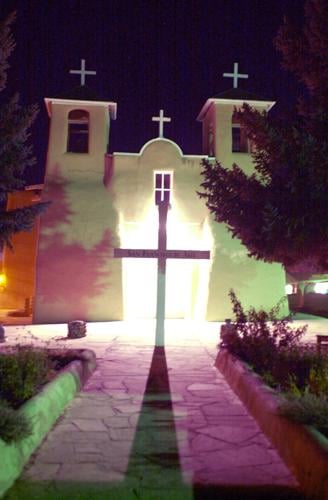
“The Shadow of the Cross” refers to a painting by an 18th-century artist, Henri Ault, that mysteriously glows in the dark.
+
When it does, it reveals the unmistakable outline of Christ, now holding a Cross.
+
That’s not visible in normal daylight.
+
With the lights on, it’s Christ by the Sea of Galilee.
+
We have mentioned this before but it’s worth revisiting.
+
The painting is located inside the parish hall of the San Francisco de Asis Church in Ranchos de Taos, New Mexico.
+
And befuddlingly, scientists have concluded, upon testing, that no luminescent materials are part of the painting’s composition (at least by most accounts).
+
But in the dark, the silhouette of Jesus grows three-dimensional and appears more like a dark statue than a flat image. And the Lord’s robes seem to billow in a breeze.
+
Over His left shoulder, that silhouette of a Cross is distinct to most. Some also see a halo over His head, and the bow of a small fishing boat on the shore.
+
Ault, a rather obscure French-Canadian artist, denied responsibility for the effect, which he claimed to have discovered fortuitously upon entering his studio one night. “He believed he was going mad, and he was never able to explain the reason for the transformation,” claims a writer named John Michell.
+
It toured Europe, did this artwork, and was even exhibited, as a curiosity, at the 1904 World’s Fair in St. Louis before donation to the church forty years later.
+
“The mystery is that when you view it in dark versus light, in the dark all you see in His shadow and a Cross appears above His left shoulder,” the parish’s business manager, Angela Valerio, once told us. “Some also see the boat in His hip area, and there is nothing like that in the painting. Everybody sees different things. It’s a very individualistic thing. The background becomes luminous. If nothing else, the painting just itself is remarkable.”
+
Remarkably, the church is famous in and of itself. It is claimed that to this day, it is still the most photographed and painted building in the country.
+
It’s also a National Historic Landmark. It was created before the discovery of radium, later used by artists to make paint glow.
+

+
One parish worker tells visitors they don’t call it a miracle. “We just say that it’s unexplainable. You will see!”
+
“With that, she turned off the light,” noted a secular reporter. “Then the image of Jesus started fading until only a silhouette was left. After two or three minutes, the image looked totally dark, and the small clouds that surrounded it—clouds that were barely visible before—became more defined and seemed to glow. Someone let out an audible gasp.”
+
Countered one skeptic, “The glowing of the paint begins to diminish after a few minutes—just like phosphorescent paint—and must be re-exposed to light for the effect to continue.”
+
Was there originally another image underneath, fashioned with phosphorescence (as opposed to radium)?
+

+
We’ll go with something a touch more mysterious.
+
+
+
+

